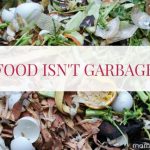650 pounds of food waste per year can be attributed to most people living in Europe and North America. With all the talk about reducing our carbon footprint, we might want to give a little attention to the personal landfills we are leaving in our wake.
Here are some practical ways you can reduce food waste in your family.
1. Write and keep your shopping list.
Taking a few minutes to plan meals before going to the grocery store means that you can get exactly what you need and avoid extras that will just go to waste. These don’t haveto be too rigid, but a little thought will enable you to shop wisely. The majority of Western food waste is due to a simple lack of planning.
Afterwards, don’t throw your list out. Hang it on your refrigerator as a reminder of what’s inside. After all, no matter how organized you are, something will end up in the back of the fridge. Seeing your list will keep those hidden items in the front of your mind.
2. Save scraps for stock.
One of the best ways to save money and get the most bang for your buck is to freeze kitchen scraps and make your own homemade stock. It is ridiculously easy and makes your food taste better for free. You can get specific steps here.
3. Share what you don’t need.
Who goes through that entire bunch of cilantro before it turns yellow?
There is no reason you can’t offer your extra portions to neighbors. Whenever you have too much, be honest with yourself and share with those around you. If you baked too many cookies, offer them to coworkers. Not only will people like you for sharing, but you’ll reduce waste and encourage them to do the same.
4. Make your own dog food.
Kitchen scraps can go to the dogs. There are lots of recipes which incorporate things like eggshells in their ingredient list. Years ago, I used to save my shells for a neighbor who didn’t eat eggs, but needed them for her homemade dog food. Why not?
5. Blitz away imperfections.
When fruit or veggies are wilting or blemished, use your blender. You can make soups, smoothies and even quick breads with past-prime produce.
6. Compost, compost, compost.
Even if you live in an apartment, there are many community compost centers popping up everyday. Composting your organic waste allows it to convert into nutrient rich soil that will feed gardens. By keeping organic waste out of the regular trash, you allow that natural process to occur. When organics are mixed with non-biodegradable, toxic trash, their natural decay is delayed.
7. Always zest citrus.
You can add zest to baked goods, smoothies, sauces, yogurt, veggies, you name it. You can also add it to vinegar to make natural cleaning more pleasant to your nose. If you don’t have an immediate use for zest, spread it out on a plate and allow it to dry. Store dried zest in an airtight container until you need it. This adds great flavor to food and also gets an extra use out of what could have been waste.
8. Experiment with regrowing foods from kitchen scraps.
Talk about buy-one-get-one-free! Check out ingenious ways you can reincarnate veggie scraps. The easiest one is to just put the bottom of a scallion in water and let it grow. You can’t do this indefinitely as the nutrients will deplete without soil, but you can get an extra bit of food and a great science project for kids by putting your garbage in water and letting it grow. I have a pineapple field (8!) growing in my backyard from tops of pineapples we planted in the ground.
9. Make your own food.
The more you cook, the more you appreciate food. You connect to the ingredients and effort in a way that you just can’t do with take-out and frozens.
One of Michael Pollan’s Food Rules is: You can eat whatever junk food you want as long as you make it yourself. Making potato chips is tricky and a mess to clean up, but when you eat them, you savor them. Prepackaged chips are a mindless snack, but we should never be mindless about food. That’s what enables waste. Believe me, I make my own jam and I never allow a spoonful to drizzle and drip away. I recall picking, cutting, cooking, and canning the fruit. That effort prompts reverence on my part.
10. Have a smorgasbord once or twice a week.
If leftovers aren’t eaten for lunch the next day, they can pile up: a little of this, a little of that. Oftentimes there just isn’t enough left to turn into a family meal. Of course, you can use some leftovers in omelets, but the easiest thing to do is reheat it all and let your family dig in to their favorites. You can add a salad, rice, or some eggs to round out any holes in the meal. The bonus is a day off from cooking. I like to call these meals Highlights from the Week.
11. Put a fruits and veggies in a high traffic area.
Snacks are grab and go. If we see a healthy option, we are more likely to eat it. Psychological journals are full of analysis of why we resist overcoming simple hurdles like opening a refrigerator door, but they exist. If you buy food for people to eat, put it where they can see it. I will never forget the sweltering summer I spent with my aunt in Virginia when I was in high school. Everyday she put out a bowl of juicy plums, and everyday my cousins and I gobbled them up as we ran past the bowl.
Another aunt of mine puts a plate of cut veggies and hummus on her counter an hour before dinner. Kids walk by and munch without thinking. I doubt that her teenagers would actually open up the fridge, peel, and cut carrots, but they grab some passing by. This is so much better than letting them go limp in the crisper.
12. Perish perishables first.
Meal planning is great. If you can stick to your plans, my hat goes off to you. For me, precision doesn’t work. I have a general idea of what I’m going to make during the week, but rigid plans always tend to fall apart. A surprise invitation, a late lunch, a bad day, or even a shift in the weather changes my menu.
One rule that works well for me is to always eat my perishables first. I often look in my kitchen for what is going bad and cook that right away. This rule works well for preventing extra trips to the grocery store too. Fragile greens, tomatoes and berries are gobbled up early in the week, followed by heartier ground and root vegetables and tree fruit. Frozen veggies remain untouched until I run out of fresh food or time.
Do you have another tip for reducing food waste? Please share in the comments. We’re all in this together!







Leave a Reply